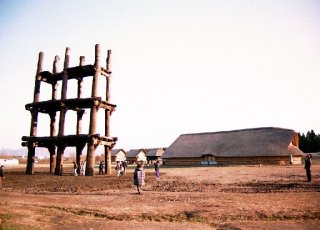
|
- Although the existence of Sannai-Maruyama remains itself has been known sice old times, in the 5th year of Heisei Era, during the construction of a new baseball stadium, a huge quantity of items that man has never imagined have been unearthed. So it is concluded that from the first Jomon Era (about 5500 years ago) until the middle Jomon Era (about 4000 years ago), a large village should have existed here for more than 1500 years.
- Jomon Era runs from about 12,000 BC to between 200 and 300 BC. After the earth having passed the last glacial period and begun to heat up, its temperature reached the peak just before the era of Sannai-Maruyama remains, 6000 years ago. For that reason, at that period, the cost line was very close to the remains which are now completely inland.
- After the discovery of rests of 6 huge chestnut trees of 1 m diameter, the conservation of the remains has been decided. After a dispute among scholars on the existence of a roof, a watch tower of 20m high has been finally restored without it. In order to reconstruct it, man brought big chestnut trees all the way from Russian Ural Mountains.
- Before the discovery of Sannai-Maruyama remains, it was commonly admitted that during Jomon Era, groups of at most dozens persons should have been living together in caves or behind rocks, chasing animals or collecting chestnuts. The reconstruction of a great house of 32 high and 9 m wide has overthrown completely that vision.
- This big tree remains have been built from 2.7m under the earth and orderly aligned with the same distance of 4.2m. Having only holes and remains of tree pillars as clues, it is impossible to conclude what had been built on the surface from such different theories as shrine, watch tower, sundial, monument for sun god etc.
|

 Japanese display
Japanese display
 French display
French display

